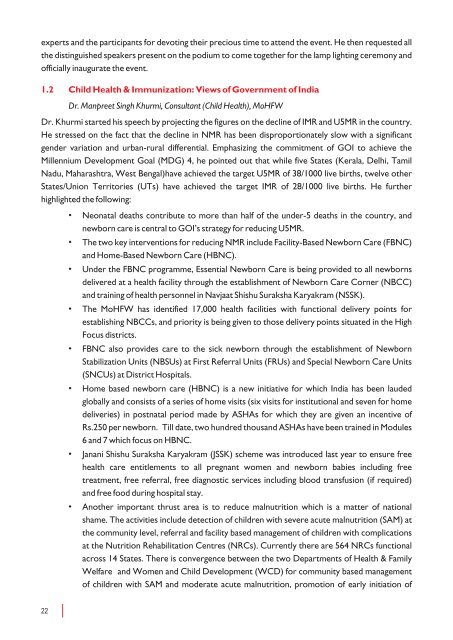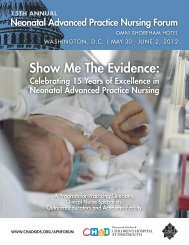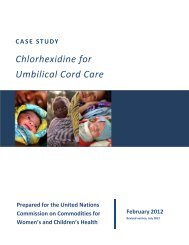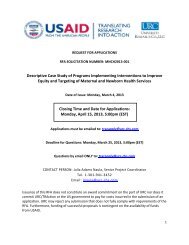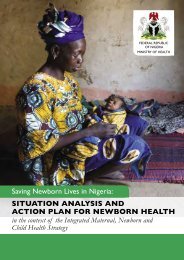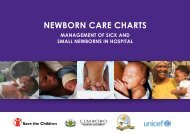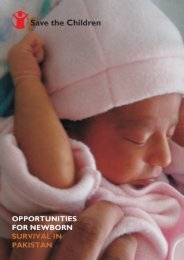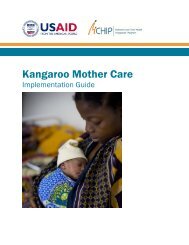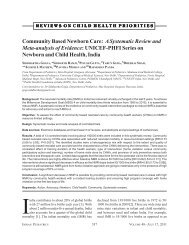Download Resource - Healthy Newborn Network
Download Resource - Healthy Newborn Network
Download Resource - Healthy Newborn Network
You also want an ePaper? Increase the reach of your titles
YUMPU automatically turns print PDFs into web optimized ePapers that Google loves.
experts and the participants for devoting their precious time to attend the event. He then requested allthe distinguished speakers present on the podium to come together for the lamp lighting ceremony andofficially inaugurate the event.1.2 Child Health & Immunization: Views of Government of IndiaDr. Manpreet Singh Khurmi, Consultant (Child Health), MoHFWDr. Khurmi started his speech by projecting the figures on the decline of IMR and U5MR in the country.He stressed on the fact that the decline in NMR has been disproportionately slow with a significantgender variation and urban-rural differential. Emphasizing the commitment of GOI to achieve theMillennium Development Goal (MDG) 4, he pointed out that while five States (Kerala, Delhi, TamilNadu, Maharashtra, West Bengal)have achieved the target U5MR of 38/1000 live births, twelve otherStates/Union Territories (UTs) have achieved the target IMR of 28/1000 live births. He furtherhighlighted the following:• Neonatal deaths contribute to more than half of the under-5 deaths in the country, andnewborn care is central to GOI’s strategy for reducing U5MR.• The two key interventions for reducing NMR include Facility-Based <strong>Newborn</strong> Care (FBNC)and Home-Based <strong>Newborn</strong> Care (HBNC).• Under the FBNC programme, Essential <strong>Newborn</strong> Care is being provided to all newbornsdelivered at a health facility through the establishment of <strong>Newborn</strong> Care Corner (NBCC)and training of health personnel in Navjaat Shishu Suraksha Karyakram (NSSK).• The MoHFW has identified 17,000 health facilities with functional delivery points forestablishing NBCCs, and priority is being given to those delivery points situated in the HighFocus districts.• FBNC also provides care to the sick newborn through the establishment of <strong>Newborn</strong>Stabilization Units (NBSUs) at First Referral Units (FRUs) and Special <strong>Newborn</strong> Care Units(SNCUs) at District Hospitals.• Home based newborn care (HBNC) is a new initiative for which India has been laudedglobally and consists of a series of home visits (six visits for institutional and seven for homedeliveries) in postnatal period made by ASHAs for which they are given an incentive ofRs.250 per newborn. Till date, two hundred thousand ASHAs have been trained in Modules6 and 7 which focus on HBNC.• Janani Shishu Suraksha Karyakram (JSSK) scheme was introduced last year to ensure freehealth care entitlements to all pregnant women and newborn babies including freetreatment, free referral, free diagnostic services including blood transfusion (if required)and free food during hospital stay.• Another important thrust area is to reduce malnutrition which is a matter of nationalshame. The activities include detection of children with severe acute malnutrition (SAM) atthe community level, referral and facility based management of children with complicationsat the Nutrition Rehabilitation Centres (NRCs). Currently there are 564 NRCs functionalacross 14 States. There is convergence between the two Departments of Health & FamilyWelfare and Women and Child Development (WCD) for community based managementof children with SAM and moderate acute malnutrition, promotion of early initiation of22


